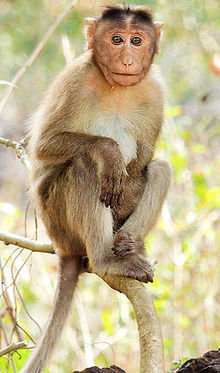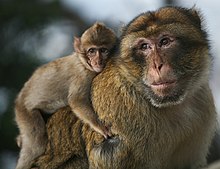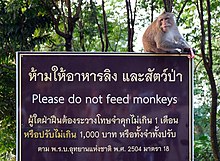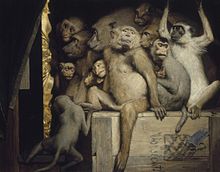Monkey
| Monkeys Temporal range:
| |
|---|---|

| |
| Bonnet macaqueMacaca radiataMangaon, Maharashtra, India | |
| Scientific classification | |
| Domain: | Eukaryota |
| Kingdom: | Animalia |
| Phylum: | Chordata |
| Class: | Mammalia |
| Order: | Primates |
| Suborder: | Haplorhini |
| Infraorder: | Simiiformes [a] |
| Groups included | |
| Cladisticallyincluded but traditionally excluded taxa | |
Monkeyis a common name that may refer to most mammals of theinfraorderSimiiformes,also known as the simians. Traditionally, all animals in the group now known as simians are counted as monkeys except theapes.Thus monkeys, in that sense, constitute an incompleteparaphyleticgrouping; however, in the broader sense based oncladistics,apes (Hominoidea) are also included, making the termsmonkeysandsimianssynonyms in regard to their scope.
In 1812,Étienne Geoffroygrouped theapesand theCercopithecidaegroup of monkeys together and established the nameCatarrhini,"Old World monkeys", ( "singes de l'Ancien Monde"inFrench).[3][4][5]The extant sister of the Catarrhini in the monkey ( "singes" ) group is thePlatyrrhini(New World monkeys).[3]Some nine million years before the divergence between the Cercopithecidae and the apes,[6]the Platyrrhini emerged within "monkeys" by migration to South Americafrom Afro-Arabia (the Old World),[citation needed][7][8]likely by ocean.[9][10][better source needed]Apes are thus deep in the tree of extant and extinct monkeys, and any of the apes is distinctly closer related to the Cercopithecidae than the Platyrrhini are.
Many monkey species are tree-dwelling (arboreal), although there are species that live primarily on the ground, such asbaboons.Most species are mainly active during the day (diurnal). Monkeys are generallyconsidered to be intelligent,especially the Old World monkeys.
Within suborderHaplorhini,the simians are a sister group to thetarsiers– the two members diverged some 70 million years ago.[11]New World monkeys and catarrhine monkeys emerged within the simians roughly 35 million years ago. Old World monkeys and apes emerged within the catarrhine monkeys about 25 million years ago. Extinct basal simians such asAegyptopithecusorParapithecus(35–32 million years ago) are also considered monkeys by primatologists.[12][9][13][14][15][16]
Lemurs,lorises,andgalagosare not monkeys, butstrepsirrhineprimates (suborder Strepsirrhini). The simians'sister group,the tarsiers, are also haplorhine primates; however, they are also not monkeys.[citation needed]
Apes emerged within monkeys as sister of the Cercopithecidae in the Catarrhini, so cladistically they are monkeys as well. However, there has been resistance to directly designate apes (and thus humans) as monkeys, so "Old World monkey" may be taken to mean either the Cercopithecoidea (not including apes) or the Catarrhini (including apes).[17][18][19][20][21][22][23][24][25]That apes are monkeys was already realized byGeorges-Louis Leclerc, Comte de Buffonin the 18th century.[26]Linnaeusplaced this group in 1758 together with the tarsiers, in a single genus "Simia"(sansHomo), an ensemble now recognised as the Haplorhini.[27]
Monkeys, including apes, can be distinguished from other primates by having only two pectoral nipples, a pendulous penis, and a lack of sensorywhiskers.[28][better source needed]
Historical and modern terminology

According to theOnline Etymology Dictionary,the word "monkey" may originate in aGermanversion of theReynard the Foxfable, publishedc. 1580.In this version of the fable, a character named Moneke is the son of Martin the Ape.[29]In English, no clear distinction was originally made between "ape" and "monkey"; thus the 1911Encyclopædia Britannicaentry for "ape" notes that it is either a synonym for "monkey" or is used to mean a tailless humanlike primate.[30]Colloquially, the terms "monkey" and "ape" are widely used interchangeably.[31][32]Also, a few monkey species have the word "ape" in their common name, such as theBarbary ape.
Later in the first half of the 20th century, the idea developed that there were trends inprimate evolutionand that the living members of the order could be arranged in a series, leading through "monkeys" and "apes" to humans.[33]Monkeys thus constituted a "grade"on the path to humans and were distinguished from" apes ".
Scientific classifications are now more often based onmonophyleticgroups, that is groups consisting ofallthe descendants of a common ancestor. The New World monkeys and the Old World monkeys are each monophyletic groups, but their combination was not, since it excluded hominoids (apes and humans). Thus, the term "monkey" no longer referred to a recognized scientifictaxon.The smallest accepted taxon which contains all the monkeys is the infraorderSimiiformes,or simians. However this also contains the hominoids, so that monkeys are, in terms of currently recognized taxa, non-hominoid simians. Colloquially and pop-culturally, the term is ambiguous and sometimes monkey includes non-human hominoids.[34]In addition, frequent arguments are made for a monophyletic usage of the word "monkey" from the perspective that usage should reflect cladistics.[21][35][36][37][38]
Several science-fiction and fantasy stories have depicted non-human (fantastical or alien) antagonistic characters refer tohumansas monkeys, usually in a derogatory manner, as a form ofmetacommentary.[39]
A group of monkeys may be commonly referred to as a tribe or a troop.[40]
Two separate groups of primates are referred to as "monkeys":New World monkeys(platyrrhines) from South and Central America and Old World monkeys (catarrhinesin the superfamily Cercopithecoidea) from Africa and Asia.Apes(hominoids)—consisting ofgibbons,orangutans,gorillas,chimpanzeesandbonobos,andhumans—are also catarrhines but were classically distinguished from monkeys.[41][9][42][43]Tailless monkeys may be called "apes", incorrectly according to modern usage; thus the taillessBarbary macaqueis historically called the "Barbary ape".[32]
Description
As apes have emerged in the monkey group as sister of the old world monkeys, characteristics that describe monkeys are generally shared by apes as well. Williams et al. outlined evolutionary features, including in stem groupings, contrasted against the other primates such as thetarsiersand thelemuriformes.[44]
Monkeys range in size from thepygmy marmoset,which can be as small as117 mm (4+5⁄8in) with a172 mm (6+3⁄4in) tail and just over100 g (3+1⁄2oz) in weight,[45]to the malemandrill,almost 1 m (3 ft 3 in) long and weighing up to 36 kg (79 lb).[46]Some arearboreal(living in trees) while others live on thesavanna;diets differ among the various species but may contain any of the following: fruit, leaves, seeds, nuts, flowers, eggs and small animals (including insects and spiders).[47]
Some characteristics are shared among the groups; most New World monkeys have long tails, with those in the Atelidae family beingprehensile,while Old World monkeys have non-prehensile tails or no visible tail at all.[32]Old World monkeys havetrichromaticcolor visionlike that of humans, while New World monkeys may be trichromatic,dichromatic,or—as in theowl monkeysandgreater galagos—monochromatic.Although both the New and Old World monkeys, like the apes, have forward-facing eyes, the faces of Old World and New World monkeys look very different, though again, each group shares some features such as the types of noses, cheeks and rumps.[47]
Classification
The following list shows where the various monkey families (bolded) are placed in the classification of living (extant) primates.
- OrderPrimates
- SuborderStrepsirrhini:lemurs,lorises,andgalagos
- SuborderHaplorhini:tarsiers,monkeys, andapes
- InfraorderTarsiiformes
- FamilyTarsiidae:tarsiers
- InfraorderSimiiformes:simians
- ParvorderPlatyrrhini:New World monkeys
- FamilyCallitrichidae:marmosetsandtamarins(42 species)
- FamilyCebidae:capuchinsandsquirrel monkeys(14 species)
- FamilyAotidae:night monkeys(11 species)
- FamilyPitheciidae:titis,sakis,anduakaris(41 species)
- FamilyAtelidae:howler,spider,andwoolly monkeys(24 species)
- ParvorderCatarrhini
- SuperfamilyCercopithecoidea
- FamilyCercopithecidae:Old World monkeys (135 species)
- SuperfamilyHominoidea:apes
- FamilyHylobatidae:gibbons( "lesser apes" ) (20 species)
- FamilyHominidae:great apes (includinghumans,gorillas,chimpanzees,andorangutans) (8 species)
- SuperfamilyCercopithecoidea
- ParvorderPlatyrrhini:New World monkeys
- InfraorderTarsiiformes
Cladogram with extinct families
Below is acladogramwith some extinct monkey families.[48][49][50]Generally, extinct non-hominoid simians, including early catarrhines are discussed as monkeys as well as simians or anthropoids,[41][9][42]whichcladisticallymeans that Hominoidea are monkeys as well, restoring monkeys as a single grouping. It is indicated approximately how many million years ago (Mya) the clades diverged into newer clades.[51][52][53][54]It is thought the New World monkeys started as a drifted "Old World monkey" group from the Old World (probably Africa) to the New World (South America).[9]
| Haplorhini(64) |
| ||||||||||||||||||||||||||||||||||||||||||||||||||||||||||||||||||||||||||||||||||||||||||||||||||||||||||||||||||||||||||||||||||||||||||
Relationship with humans


The many species of monkey have varied relationships with humans. Some arekept as pets,others used asmodel organismsin laboratories or in space missions. They may be killed inmonkey drives(when they threaten agriculture) or used asservice animalsfor the disabled.
In some areas, some species of monkey are considered agriculturalpests,and can cause extensive damage to commercial and subsistence crops.[55][56]This can have important implications for the conservation of endangered species, which may be subject to persecution. In some instances farmers' perceptions of the damage may exceed the actual damage.[57]Monkeys that have become habituated to human presence in tourist locations may also be considered pests, attacking tourists.[58]
Public exhibition
Many zoos have maintained a facility in which monkeys and other primates are kept within enclosures for public entertainment. Commonly known as a monkey house (primatarium), sometimes styledMonkey House,notable examples include London Zoo'sMonkey Valley;[59][60]Zoo Basel's Monkey house/exhibit;theMonkey Tropic Houseat Krefeld Zoo;Bronx Zoo's Monkey House;Monkey Jungle,Florida;Lahore Zoo's Monkey House;Monkey World,Dorset, England; andEdinburgh Zoo's Monkey House.Former cinema,The Scala, Kings Crossspent a short time as a primatarium.[61]
As service animals for disabled people
Some organizations traincapuchin monkeysasservice animalsto assistquadriplegicsand other people with severe spinal cord injuries ormobility impairments.After beingsocializedin a human home as infants, the monkeys undergo extensive training before being placed with disabled people. Around the house, the monkeys assist withdaily taskssuch as feeding, fetching, manipulating objects, and personal care.[62]
Helper monkeysare usually trained in schools by private organizations, taking seven years to train, and are able to serve 25–30 years (two to three times longer than aguide dog).[63]
In 2010, theU.S. federal governmentrevised its definition of service animal under theAmericans with Disabilities Act(ADA). Non-human primates are no longer recognized as service animals under the ADA.[64]TheAmerican Veterinary Medical Associationdoes not support the use of non-human primates as assistance animals because ofanimal welfareconcerns, the potential for serious injury to people, and risks that primatesmay transfer dangerous diseases to humans.[65]
In experiments
The most common monkey species found in animal research are thegrivet,therhesus macaque,and thecrab-eating macaque,which are either wild-caught or purpose-bred.[66][67]They are used primarily because of their relative ease of handling, their fast reproductive cycle (compared to apes) and their psychological and physical similarity tohumans.Worldwide, it is thought that between 100,000 and 200,000 non-human primates are used in research each year,[67]64.7% of which are Old World monkeys, and 5.5% New World monkeys.[68]This number makes a very small fraction of all animals used in research.[67]Between 1994 and 2004 the United States has used an average of 54,000 non-human primates, while around 10,000 non-human primates were used in theEuropean Unionin 2002.[68]
In space

A number of countries have used monkeys as part of their space exploration programmes, including the United States and France. The first monkey in space wasAlbert II,who flew in the US-launchedV-2 rocketon June 14, 1949.[69]
As food
Monkey brainsare eaten as a delicacy in parts ofSouth Asia,Africa and China.[70]Monkeys are sometimes eaten in parts of Africa, where they can be sold as "bushmeat".In traditionalIslamic dietary laws,the eating of monkeys isforbidden.[71]
Literature

Sun Wukong(the "Monkey King" ), a character who figures prominently inChinese mythology,is the protagonist in the classic Chinese novelJourney to the West.
Monkeys are prevalent in numerous books, television programs, and movies. Thetelevision seriesMonkeyand the literary charactersMonsieur EekandCurious Georgeare all examples.
Informally, "monkey" may refer to apes, particularly chimpanzees, gibbons, and gorillas. AuthorTerry Pratchettalludes to this difference in usage in hisDiscworldnovels, in which theLibrarianof theUnseen Universityis anorangutanwho gets very violent if referred to as a monkey. Another example is the use ofSimians in Chinese poetry.
Thewinged monkeysare prominent characters inL. Frank Baum'sWizard of Ozbooks and in the1939 filmbased on Baum's 1900 novelThe Wonderful Wizard of Oz.
Religion and worship

Monkey is the symbol of fourthTirthankarainJainism,Abhinandananatha.[72][73]
Hanuman,a prominent deity inHinduism,is a human-like monkey god who is believed to bestow courage, strength and longevity to the person who thinks about him orRama.
InBuddhism,the monkey is an early incarnation of Buddha but may also represent trickery and ugliness. TheChinese Buddhist"mind monkey"metaphor refers to the unsettled, restless state of human mind. Monkey is also one of the Three Senseless Creatures, symbolizing greed, with the tiger representing anger and the deer lovesickness.
TheSanzaru,orthree wise monkeys,are revered in Japanese folklore; together they embody the proverbial principle to "see no evil, hear no evil, speak no evil".[74]
TheMochepeople of ancient Peru worshipped nature.[75]They placed emphasis on animals and often depicted monkeys in their art.[76]
TheTzeltalpeople of Mexico worshipped monkeys as incarnations of their dead ancestors.
Zodiac

TheMonkey( hầu ) is the ninth in the twelve-year cycle of animals which appear in theChinese zodiacrelated to theChinese calendar.The next time that the monkey will appear as the zodiac sign will be in the year 2028.[77]
See also
- List of New World monkey species
- List of cercopithecoids(Old World monkeys)
- List of individual monkeys
- List of fictional primates
- List of primates
- List of primates by population
- International Primate Day
- Monkey Day
- Signifying monkey
Notes
- ^WhenCarl Linnaeusdefined thegenusSimiain the10th edition ofSystema Naturae,it included all non-human monkeys and apes (simians).[2]Although "monkey" was never a taxonomic name, and is instead avernacular namefor a paraphyletic group, its members fall under the infraorder Simiiformes.
References
- ^Fleagle, J.; Gilbert, C. Rowe, N.; Myers, M. (eds.)."Primate evolution".All the World's Primates.Primate Conservation, Inc.Retrieved18 December2014.
- ^Groves 2008,pp. 92–93.
- ^abGeoffroy Saint-Hilaire, M.É. (1812)."Tableau des Quadrumanes, ou des animaux composant le premier Ordre de la Classe des Mammifères".Annales du Muséum d'Histoire Naturelle.19.Paris: 85–122.
- ^Martin, W.C.Linnaeus (1841).A General Introduction the Natural History Mammiferous Animals, With a Particular View of the Physical History of Man, III the More Closely Allied Genera of the Order Quadrumana, or Monkeys.London: Wright and Co. printers. pp. 340, 361.
- ^Buffon, Georges Louis Leclerc comte de (1827).Oeuvres complètes de Buffon: avec les descriptions anatomiques de Daubenton, son collaborateur(in French). Verdière et Ladrange. p. 61.
- ^"Family Cercopithecidae Cercopithecids: Old World Monkeys",Mammals of Africa: Primates,Bloomsbury Publishing (UK), 2013,doi:10.5040/9781472926920.part-0018,ISBN978-1-4729-2692-0,retrieved2022-07-13
- ^Seiffert, Erik R. (2012-12-19)."Early primate evolution in Afro-Arabia".Evolutionary Anthropology: Issues, News, and Reviews.21(6): 239–253.doi:10.1002/evan.21335.PMID23280921.S2CID38884357.
- ^Bond, Mariano; Tejedor, Marcelo F.; Campbell, Kenneth E.; Chornogubsky, Laura; Novo, Nelson; Goin, Francisco (2015-04-23)."Eocene primates of South America and the African origins of New World monkeys".Nature.520(7548): 538–541.Bibcode:2015Natur.520..538B.doi:10.1038/nature14120.hdl:11336/79088.ISSN0028-0836.PMID25652825.S2CID4456556.
- ^abcdeO'Neill, Dennis (2012)."Early primate evolution: the first primates".Palomar College.Retrieved21 October2018.
- ^Kay, Richard F. (2015-03-06)."New World monkey origins".Science.347(6226): 1068–1069.Bibcode:2015Sci...347.1068K.doi:10.1126/science.aaa9217.ISSN0036-8075.PMID25745147.S2CID206636402.
- ^Pozzi, Luca; Hdgson, Jason A.; Burrell, Andrew S.; Sterner, Kirstin N.; Raaum, Ryan L.; Disotell, Todd R. (28 February 2014)."Primate phylogenetic relationships and divergence dates inferred from complete mitochondrial genomes".Molecular Phylogenetics and Evolution.75:165–183.doi:10.1016/j.ympev.2014.02.023.PMC4059600.PMID24583291.
- ^Gabbatiss, Josh."The monkeys that sailed across the Atlantic to South America".Retrieved21 October2018.
- ^Takai, Masanaru; Shigehara, Nobuo; Aung, Aye Ko; Tun, Soe Thura; Soe, Aung Naing; Tsubamoto, Takehisa; Thein, Tin (2001). "A new anthropoid from the latest middle Eocene of Pondaung, central Myanmar".Journal of Human Evolution.40(5): 393–409.doi:10.1006/jhev.2001.0463.ISSN0047-2484.PMID11322801.
- ^"Fossilworks: Catarrhini".Fossilworks.Retrieved17 December2021.
- ^Wasson, D. A. (1868). "Epic philosophy".The North American Review.107(221): 501–542.JSTOR25109409.
- ^Simons, E. L.; Delson, E. (1978-12-31), Maglio, Vincent J.; Cooke, H. B. S. (eds.),"VII: Cercopithecidae and Parapithecidae",Evolution of African Mammals,Harvard University Press, pp. 100–119,doi:10.4159/harvard.9780674431263.c8,ISBN978-0-674-43125-6,retrieved2022-05-10
- ^Geissmann, Thomas."Die Gibbons (Hylobatidae): Eine Einführung"[The gibbons (Hylobatidae): an introduction].Gibbon Research Lab.Retrieved15 March2019.
- ^Osman Hill, W. C.(1953).Primates comparative anatomy and taxonomy I—Strepsirhini.Edinburgh Univ Pubs Science & Maths, No 3. Edinburgh University Press. p. 53.OCLC500576914.
- ^Meek, Phyllis."The Old World monkeys".University of Michigan.Retrieved20 March2019.
- ^"Reconstruction of ancient chromosomes offers insight into mammalian evolution".University of California, Davis.21 June 2017.Retrieved20 March2019.
- ^abNaish, Darren."If apes evolved from monkeys, why are there still monkeys?".Scientific American Blog Network.Scientific American.Archived fromthe originalon 13 February 2019.Retrieved4 October2018.
- ^Martin, W. C. L.(1841).A general introduction to the natural history of mammiferous animals, with a particular view of the physical history of man, and the more closely allied genera of the order Quadrumana, or monkeys.London, UK: Wright and Co. printers. pp. 340, 361.
- ^Lacoste, Vincent; Lavergne, Anne; Ruiz-García, Manuel; Pouliquen, Jean-François; Donato, Damien; James, Samantha (2018)."DNA polymerase sequences of New World monkey cytomegaloviruses: another molecular marker with which to infer Platyrrhini systematics".Journal of Virology.92(18): e00980–18.doi:10.1128/JVI.00980-18.ISSN0022-538X.PMC6146696.PMID29976674.
- ^Bugge, J. (1974). "Chapter 4: Primates Linnaeus 1758".Cells Tissues Organs.The cephalic arterial system in insectivores, primates, rodents and lagomorphs, with special reference to the systematic classification.87(Suppl. 62): 32–43.doi:10.1159/000144209.ISSN1422-6405.
- ^Melchionna, Marina (10 December 2018).Macroevolutionary analysis of Primates with special reference to the genusHomo(PDF)(PhD thesis).Università degli Studi di Napoli Federico II.Retrieved22 November2020.
- ^Martin, W. C. L.(1841).A general introduction to the natural history of mammiferous animals, with a particular view of the physical history of man, and the more closely allied genera of the order Quadrumana, or monkeys.London, UK: Wright and Co. printers. p. 339.
- ^Linné, Carl von; Salvius, Lars (1758).Caroli Linnaei...Systema naturae per regna tria naturae:secundum classes, ordines, genera, species, cum characteribus, differentiis, synonymis, locis.Vol. 1. Holmiae: Impensis Direct. Laurentii Salvii.
- ^AronRa(13 March 2019).Systematic classification of life - ep39 Simiiformes.Archived fromthe originalon 2021-10-28.Retrieved17 March2019.
- ^Harper, D. (2004)."Monkey".Online Etymology Dictionary.Retrieved10 April2013.
- ^Chisholm, Hugh,ed. (1911)..Encyclopædia Britannica.Vol. 2 (11th ed.). Cambridge University Press. p. 160.
- ^"monkey".Merriam-Webster.com Dictionary.
- ^abcWeisberger, Mindy (March 23, 2024)."Why don't humans have tails? Scientists find answers in an unlikely place".CNN.Archivedfrom the original on March 24, 2024.RetrievedMarch 24,2024.
- ^Dixson, A. F. (1981).The natural history of the gorilla.London: Weidenfeld & Nicolson. p. 13.ISBN978-0-297-77895-0.
- ^Susman, Gary."10 best monkeys at the movies".Entertainment Weekly.Archived fromthe originalon 22 February 2014.Retrieved8 February2014.
- ^"Apes are monkeys, deal with it".21 April 2011.
- ^"Are humans apes, monkeys, primates, or hominims?".19 March 2012. Archived fromthe originalon 22 December 2015.Retrieved20 December2015.
- ^"Rehabilitating" monkey "".
- ^Holtz, Thomas R."The fossil record: the scatterlings of Africa: the origins of humanity".University of Maryland.Retrieved6 February2019.
- ^"Rehabilitating" monkey "".
- ^"AskOxford: M".Collective terms for groups of animals.Oxford, United Kingdom: Oxford University Press. Archived fromthe originalon 20 October 2008.Retrieved10 April2013.
- ^abDobzhansky, Theodosius; Hecht, Max K.; Steere, William C. (2012).Evolutionary Biology.Springer Science & Business Media.ISBN9781468490633.
- ^abBajpai, Sunil; Kay, Richard F.; Williams, Blythe A.; Das, Debasis P.; Kapur, Vivesh V.; Tiwari, B. N. (2008)."The oldest Asian record of Anthropoidea".Proceedings of the National Academy of Sciences.105(32): 11093–11098.Bibcode:2008PNAS..10511093B.doi:10.1073/pnas.0804159105.ISSN0027-8424.PMC2516236.PMID18685095.
- ^Delson, Eric; Tattersall, Ian; Couvering, John Van; Brooks, Alison S. (2004).Encyclopedia of human evolution and prehistory: second edition.Routledge.ISBN9781135582289.
- ^Williams, Blythe A.; Kay, Richard F.; Kirk, E. Christopher (2010)."New perspectives on anthropoid origins".Proceedings of the National Academy of Sciences.107(11): 4797–4804.Bibcode:2010PNAS..107.4797W.doi:10.1073/pnas.0908320107.ISSN0027-8424.PMC2841917.PMID20212104.
- ^Nowak, R. M. (1999).Walker's mammals of the world(6th ed.). Baltimore and London: The Johns Hopkins University Press.ISBN978-0801857898.
- ^"Mandrill".ARKive. 2005. Archived fromthe originalon 12 May 2013.Retrieved10 April2013.
- ^abFleagle, J. G. (1998).Primate adaptation and evolution(2nd ed.). Academic Press. pp.25–26.ISBN978-0-12-260341-9.[dead link]
- ^Nengo, Isaiah; Tafforeau, Paul; Gilbert, Christopher C.; Fleagle, John G.; Miller, Ellen R.; Feibel, Craig; Fox, David L.; Feinberg, Josh; Pugh, Kelsey D. (2017)."New infant cranium from the African Miocene sheds light on ape evolution".Nature.548(7666): 169–174.Bibcode:2017Natur.548..169N.doi:10.1038/nature23456.PMID28796200.S2CID4397839.
- ^Ryan, Timothy M.; Silcox, Mary T.; Walker, Alan; Mao, Xianyun; Begun, David R.; Benefit, Brenda R.; Gingerich, Philip D.; Köhler, Meike; Kordos, László (2012)."Evolution of locomotion in Anthropoidea: the semicircular canal evidence".Proceedings of the Royal Society of London B: Biological Sciences.279(1742): 3467–3475.doi:10.1098/rspb.2012.0939.ISSN0962-8452.PMC3396915.PMID22696520.
- ^Yapuncich, Gabriel S.; Seiffert, Erik R.; Boyer, Doug M. (2017)."Quantification of the position and depth of the flexor hallucis longus groove in euarchontans, with implications for the evolution of primate positional behavior".American Journal of Physical Anthropology.163(2): 367–406.doi:10.1002/ajpa.23213.ISSN1096-8644.PMID28345775.
- ^"Amphipithecidae - overview".Encyclopedia of Life.Retrieved12 August2017.
- ^"Eosimiidae - overview".Encyclopedia of Life.Retrieved12 August2017.
- ^"Parapithecoidea - Overview".Encyclopedia of Life.Retrieved12 August2017.
- ^Marivaux, Laurent; Antoine, Pierre-Olivier; Baqri, Syed Rafiqul Hassan; Benammi, Mouloud; Chaimanee, Yaowalak; Crochet, Jean-Yves; Franceschi, Dario de; Iqbal, Nayyer; Jaeger, Jean-Jacques (2005)."Anthropoid primates from the Oligocene of Pakistan (Bugti Hills): Data on early anthropoid evolution and biogeography".Proceedings of the National Academy of Sciences of the United States of America.102(24): 8436–8441.Bibcode:2005PNAS..102.8436M.doi:10.1073/pnas.0503469102.ISSN0027-8424.PMC1150860.PMID15937103.
- ^Hill, C. M. (2000). "Conflict of Interest Between People and Baboons: Crop Raiding in Uganda".International Journal of Primatology.21(2): 299–315.doi:10.1023/A:1005481605637.hdl:10919/65514.S2CID30760377.
- ^Shivamogga (3 Dec 2019)."Farmer in Karnataka paints pet dog as tiger (to scare off monkeys)".Hindustan Times.
- ^Siex, K. S.; Struhsaker, T. T. (1999)."Colobus monkeys and coconuts: A study of perceived human-wildlife conflicts".Journal of Applied Ecology.36(6): 1009–1020.Bibcode:1999JApEc..36.1009S.doi:10.1046/j.1365-2664.1999.00455.x.S2CID84472733.
- ^Brennan, E. J.; Else, J. G.; Altmann, J. (1985). "Ecology and behaviour of a pest primate: Vervet monkeys in a tourist-lodge habitat".African Journal of Ecology.23(1): 35–44.Bibcode:1985AfJEc..23...35B.doi:10.1111/j.1365-2028.1985.tb00710.x.
- ^"ZSL Architecture".ZSL.Archived fromthe originalon 28 February 2008.Retrieved6 March2008.
- ^"London Zoo History".ZSL London Zoo.Retrieved28 February2023.
- ^"King's Cross Was Nearly Home To A Forest Of Monkeys".Londonist.2017-05-13.Retrieved2018-10-09.
- ^Sheredos, S. J. (1991)."An evaluation of capuchin monkeys trained to help severely disabled individuals".The Journal of Rehabilitation Research and Development.28(2): 91–96.doi:10.1682/JRRD.1991.04.0091.
- ^"Monkey Helpers Lend a 'Helping Hand'".Archived fromthe originalon September 27, 2006.RetrievedAugust 14,2006.
- ^"Highlights of the Final Rule to Amend the Department of Justice's Regulation Implementing Title II of the ADA".United States Department of Justice,Civil Rights Division.Archived fromthe originalon July 21, 2018.RetrievedOctober 2,2013.
- ^"Nonhuman primates as assistance animals".American Veterinary Medical Association.RetrievedAugust 14,2021.
- ^"The supply and use of primates in the EU".European Biomedical Research Association. 1996. Archived fromthe originalon 2012-01-17.
- ^abcCarlsson, H. E.; Schapiro, S. J.; Farah, I.; Hau, J. (2004). "Use of primates in research: A global overview".American Journal of Primatology.63(4): 225–237.doi:10.1002/ajp.20054.PMID15300710.S2CID41368228.
- ^abWeatherall, D., et al., (The Weatherall Committee) (2006).The use of non-human primates in research(PDF)(Report). London, UK: Academy of Medical Sciences. Archived fromthe original(PDF)on 2013-03-23.Retrieved2013-04-10.
{{cite report}}:CS1 maint: multiple names: authors list (link) - ^Bushnell, D. (1958)."The beginnings of research in space biology at the Air Force Missile Development Center, 1946–1952".History of Research in Space Biology and Biodynamics.NASA.Archivedfrom the original on 2013-05-30.Retrieved2013-04-10.
- ^Bonné, J. (2005-10-28)."Some bravery as a side dish".Today.com.Retrieved2009-08-15.
- ^Institut De Recherche Pour Le Développement (2002)."Primate Bushmeat: Populations Exposed To Simian Immunodeficiency Viruses".ScienceDaily.Retrieved2009-08-15.
- ^Experts, Disha (2017-12-25).THE MEGA YEARBOOK 2018 - Current Affairs & General Knowledge for Competitive Exams with 52 Monthly ebook Updates & eTests - 3rd Edition.Disha Publications.ISBN9789387421226.
- ^Reddy (2006-12-01).Indian Hist (Opt).McGraw-Hill Education (India) Pvt Limited.ISBN9780070635777.
- ^Cooper, J. C. (1992).Symbolic and Mythological Animals.London: Aquarian Press. pp. 161–63.ISBN978-1-85538-118-6.
- ^Benson, E. (1972).The Mochica: A Culture of Peru.New York: Praeger Press.ISBN978-0-500-72001-1.
- ^Berrin, K. &Museo Arqueológico Rafael Larco Herrera(1997).The Spirit of Ancient Peru: Treasures from the Museo Arqueológico Rafael Larco Herrera.New York:Thames & Hudson.ISBN978-0-500-01802-6.
- ^Lau, T. (2005).The Handbook of Chinese Horoscopes(5th ed.). New York: Souvenir Press. pp.238–244.ISBN978-0060777777.
Literature cited
- Groves, C.(2008).Extended Family: Long Lost Cousins.Conservation International.ISBN978-1-934151-25-9.OCLC300051037.
Further reading
- "How to Avoid Monkey Bites and Attacks in Southeast Asia"by Gregory Rodgers, Trip Savvy, 21 Dec 2018
- "Monkeys and Monkey Gods in Mythology, Folklore, and Religion"by Anniina Jokinen, Luminarium: Anthology of English Literature
- "The Impossible Housing and Handling Conditions of Monkeys in Research Laboratories",by Viktor Reinhardt, International Primate Protection League, August 2001
- The Problem with Pet Monkeys: Reasons Monkeys Do Not Make Good PetsArchived2014-07-12 at theWayback Machine,an article by veterinarian Lianne McLeod on About.com
- Helping Hands: Monkey helpers for the disabled,a U.S. national non-profit organization based in Boston Massachusetts that places specially trained capuchin monkeys with people who are paralyzed or who live with other severe mobility impairments
